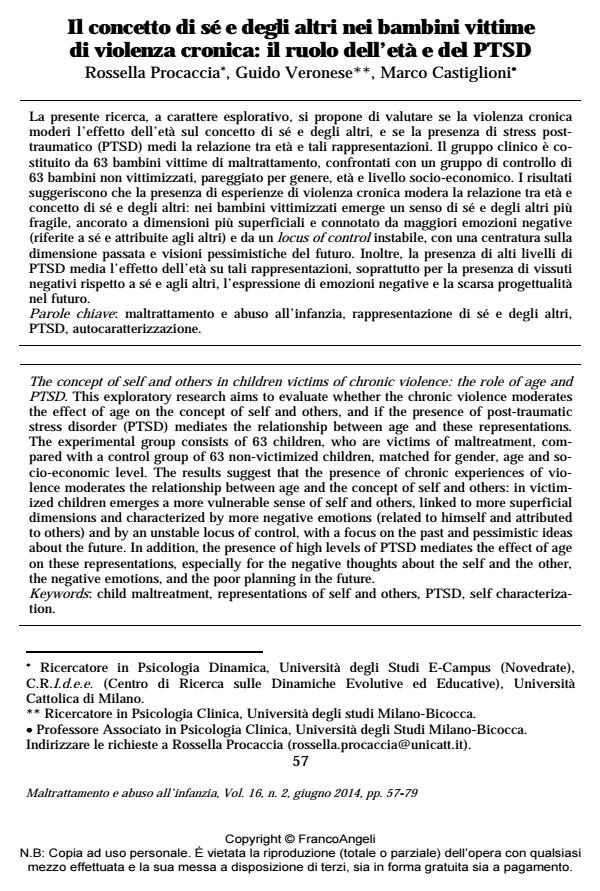Il concetto di sé e degli altri nei bambini vittime di violenza cronica: il ruolo dell’età e del PTSD
Titolo Rivista MALTRATTAMENTO E ABUSO ALL’INFANZIA
Autori/Curatori Rossella Procaccia, Guido Veronese, Marco Castiglioni
Anno di pubblicazione 2014 Fascicolo 2014/2
Lingua Italiano Numero pagine 23 P. 57-79 Dimensione file 108 KB
DOI 10.3280/MAL2014-002004
Il DOI è il codice a barre della proprietà intellettuale: per saperne di più
clicca qui
Qui sotto puoi vedere in anteprima la prima pagina di questo articolo.
Se questo articolo ti interessa, lo puoi acquistare (e scaricare in formato pdf) seguendo le facili indicazioni per acquistare il download credit. Acquista Download Credits per scaricare questo Articolo in formato PDF

FrancoAngeli è membro della Publishers International Linking Association, Inc (PILA)associazione indipendente e non profit per facilitare (attraverso i servizi tecnologici implementati da CrossRef.org) l’accesso degli studiosi ai contenuti digitali nelle pubblicazioni professionali e scientifiche
La presente ricerca, a carattere esplorativo, si propone di valutare se la violenza cronica moderi l’effetto dell’età sul concetto di sé e degli altri, e se la presenza di stress posttraumatico (PTSD) medi la relazione tra età e tali rappresentazioni. Il gruppo clinico è costituito da 63 bambini vittime di maltrattamento, confrontati con un gruppo di controllo di 63 bambini non vittimizzati, pareggiato per genere, età e livello socio-economico. I risultati suggeriscono che la presenza di esperienze di violenza cronica modera la relazione tra età e concetto di sé e degli altri: nei bambini vittimizzati emerge un senso di sé e degli altri più fragile, ancorato a dimensioni più superficiali e connotato da maggiori emozioni negative (riferite a sé e attribuite agli altri) e da un locus of control instabile, con una centratura sulla dimensione passata e visioni pessimistiche del futuro. Inoltre, la presenza di alti livelli di PTSD media l’effetto dell’età su tali rappresentazioni, soprattutto per la presenza di vissuti negativi rispetto a sé e agli altri, l’espressione di emozioni negative e la scarsa progettualità nel futuro.
Parole chiave:Maltrattamento e abuso all’infanzia, rappresentazione di sé e degli altri, PTSD, autocaratterizzazione
- Dalla violenza assistita al lutto traumatico: i bambini orfani speciali Marvita Goffredo, Francesca Lovero, Antonella Magno, Daniela Prudente, Daniela Racanelli, Alessandra Sgaramella, Marica Urbano, Alessandra Cervinara, Alessandro Costantini, Maria Grazia Foschino Barbaro, in MALTRATTAMENTO E ABUSO ALL'INFANZIA 1/2019 pp.73
DOI: 10.3280/MAL2019-001006 - Linguistic Predictors of Psychological Adjustment in Healthcare Workers during the COVID-19 Pandemic Marco Castiglioni, Cristina Liviana Caldiroli, Attà Negri, Gian Mauro Manzoni, Rossella Procaccia, in International Journal of Environmental Research and Public Health /2023 pp.4482
DOI: 10.3390/ijerph20054482 - Does resilience mediate the association between mental health symptoms and linguistic markers of trauma processing? Analyzing the narratives of women survivors of intimate partner violence Marco Castiglioni, Cristina Liviana Caldiroli, Gian Mauro Manzoni, Rossella Procaccia, in Frontiers in Psychology 1211022/2023
DOI: 10.3389/fpsyg.2023.1211022 - L'ascolto del minore vittima di violenza tra esigenze cliniche e giuridiche Rossella Procaccia, in MALTRATTAMENTO E ABUSO ALL'INFANZIA 2/2016 pp.7
DOI: 10.3280/MAL2016-002001 - Child abuse potential inventory in Italy: A comparative study of abusive and nonabusive parents Sarah Miragoli, Elena Camisasca, Paola Di Blasio, Luca Milani, Chiara Ionio, Nico Gizzi, Angela Cammarella, Marisa Malagoli Togliatti, in Journal of Child Custody /2016 pp.289
DOI: 10.1080/15379418.2016.1250145
Rossella Procaccia, Guido Veronese, Marco Castiglioni, Il concetto di sé e degli altri nei bambini vittime di violenza cronica: il ruolo dell’età e del PTSD in "MALTRATTAMENTO E ABUSO ALL’INFANZIA" 2/2014, pp 57-79, DOI: 10.3280/MAL2014-002004